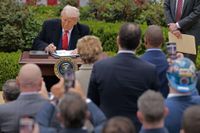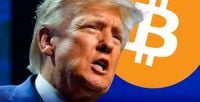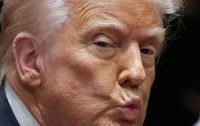U.S. President Donald Trump has announced a sweeping set of tariffs that have sent shockwaves through global markets, impacting everything from cryptocurrency prices to traditional commodities. During a live address on April 2, 2025, Trump declared a base tariff of 10% to be applied universally to all countries, while also specifying higher tariffs for certain nations based on their trade practices.
In a move that many are calling a "Declaration of Economic Independence," Trump outlined a comprehensive list of tariffs affecting major trading partners. The European Union will face a 20% tariff on goods from each member country, while imports from Japan will be hit with a 24% duty. Other countries, including China, the United Kingdom, and Israel, will also see significant tariffs: China at 34%, the UK at 10%, and Israel at 17%. The complete list includes tariffs on India (26%), South Korea (25%), Vietnam (46%), Taiwan (32%), and Thailand (36%).
Trump's announcement came as a surprise to many investors, and the market reaction was swift. Bitcoin, which had recently reached a high of $88,060 on March 26, 2025, fell sharply in the wake of the tariffs. The cryptocurrency dropped to a low of $82,143, marking a 3% decline from its daily peak of $87,400. As of the announcement, Bitcoin was trading just above $83,000, reflecting a significant drop from earlier highs.
While Bitcoin struggled, gold prices soared to an all-time high of $3,152 per ounce, a 10% increase since Trump first hinted at tariffs in early March. As investors fled to safe-haven assets, gold's rise underscored its status as a reliable hedge against economic instability. Spot gold traded at $3,128 per ounce, while U.S. gold futures settled at the record high of $3,152.
Market analysts are drawing parallels between the current situation and previous economic downturns, noting that Bitcoin's price correlation to the Nasdaq 100 index stands at 0.74%. This means that a decline in major U.S. tech stocks could lead to a corresponding drop in Bitcoin prices. The growing involvement of the U.S. government in cryptocurrency markets, particularly through publicly traded firms like BlackRock and MicroStrategy, adds to the uncertainty surrounding Bitcoin's future.
In the wake of the tariff announcement, several cryptocurrency-related stocks also suffered in after-hours trading. MicroStrategy (MSTR) saw a decline of about 7%, while crypto exchange Coinbase Global (COIN) fell by 6%, and Robinhood (HOOD) dropped nearly 9%. This broad sell-off reflects growing investor concerns over escalating trade tensions and their potential impact on risk assets.
Despite the bearish outlook for Bitcoin, some analysts remain cautiously optimistic. One prominent crypto analyst suggested that there is a "50-50 shot" for a potential rebound in Bitcoin prices, depending on how the market absorbs the news of the tariffs. As the situation evolves, traders are left grappling with the implications of Trump's aggressive trade policies on their investments.
The tariffs are not just limited to cryptocurrency markets; they have broader implications for global trade and economic relations. Trump's administration has framed these measures as a way to protect American industries that have been "unfairly treated" in international trade agreements for decades. In his address, Trump stated, "April 2, 2025, will forever be remembered as the day American industry was reborn, the day America's destiny was reclaimed, and the day that we began to Make America Wealthy Again."
As the dust settles from the announcement, it is clear that the global economic landscape is undergoing a significant transformation. With retaliatory measures likely from affected nations, the coming weeks will be crucial in determining how these tariffs will reshape international trade dynamics.
In conclusion, the financial markets are bracing for a tumultuous period as the implications of Trump's new tariffs become clearer. Investors are advised to proceed with caution, weighing the risks associated with both traditional and digital assets in an increasingly uncertain economic environment.








